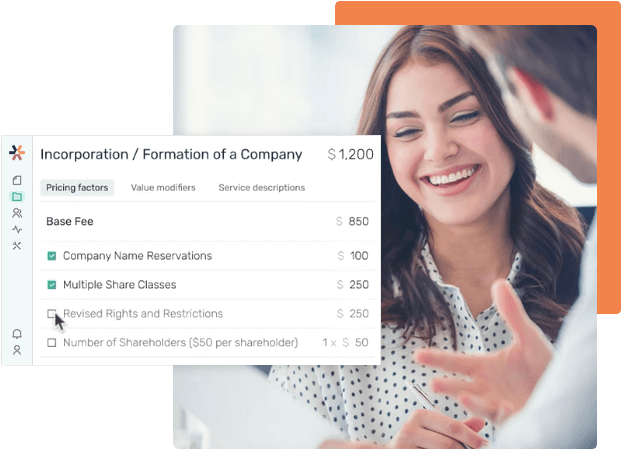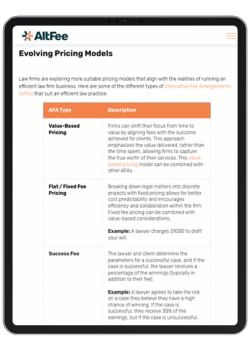- Resources
- How to Increase Law Firm Utilization Rate [7 Pro Tips]
Table of Contents
Law firm success in modern times depends on how well you can both give price certainty to your clients, and how much you pay attention to legal KPIs that indicate the performance of your law firm — including utilization rate. This metric gives a percentage of your law firm’s workload and productivity by dividing billable hours by the number of hours worked in a given day.
We’ll get more into the nitty-gritty of utilization rates in the first section of this article, but for now, the most important thing you need to know is that a high utilization rate (also called a resource utilization rate) is good, while a low one is bad.
But the reality is that a law firm having a low utilization rate is actually very common. This means that lawyers often feel obligated to work beyond the typical 40-hour work week to meet billable hour requirements.
On top of that, lawyers are not only well known for working long hours but also for only getting paid for some of those hours due to having to misreport or give discounts to appease clients that are unhappy with their bills.
This often leads to lawyer burnout as well as having a major negative effect on a law firm’s bottom line by affecting two other metrics: realization rate and collection rate.
- Realization rate measures how many billable hours were invoiced, divided by the number of hours actually worked.
- Collection rate measures how many of those billable hours were actually paid by clients, versus how many hours were invoiced.
The reason why we needed to mention these other two metrics in addition to the utilization rate is that they all closely relate to each other. The common denominator with all these metrics is the billable hour. When the billable hour is affected, it doesn’t just lower your law firm’s utilization rate, it affects all three major KPIs that you use to measure the success of your law firm. And that’s an important bit of information to keep in mind.
In this article, however, we’re focusing on utilization rate specifically, including its definition, why law firms should pay attention to it, and, most importantly, ”what is a good utilization rate”. This includes a conversation about the billable hour, and some reference to the other important metrics (realization rate, collection rate) as well.
What is Utilization Rate in the Legal Field
In the legal field, the utilization rate definition is the amount of time that’s used for productive, billable work, divided by hours worked in a day. This is typically measured for an entire law firm, but it can be measured for individual employees as well.
For example, using a typical utilization rate calculation, if an individual employee recorded 3 billable hours in an 8-hour work day, then their utilization rate would be 37.5%.
There are other ways to calculate utilization rates for your law firm which we’ll get into later in this article.
Why is Utilization Rate Important for Law Firms
Law firms, like any business, need to be able to objectively measure how successful they are at any given time. This helps determine operations risk and allows law firms to plan for the future.
When law firms calculate their utilization rate, the result paints a picture of the firm’s overall efficiency and productivity. It also gives important insight into how much time legal professionals are spending on billable work.
For instance, if too much time is spent on administrative tasks and not enough time on client work, the utilization rate can tell that story. From there, the law firm would adjust workflow operations accordingly in an attempt to help legal professionals focus more time on the billable work rather than the non-billable administrative tasks.
It’s important to note that even though we’re using the terms billable and non-billable work, that doesn’t mean that we’re excluding law firms that use alternative fee arrangements. Even if a task is billed to the client at a flat fee or another type of fee that differs from the billable hour, that doesn’t necessarily mean that time spent isn’t tracked. After all, law firms, just like any other business, still need to factor in time spent when pricing out their services. There’s just less time spent overall chasing the billable hour with alternative fee structures when compared to the traditional billable hour.
Utilization Rate Statistics
There are a variety of statistics available on utilization rates and how they affect law firms. Many of these statistics surround the amount of billable versus non-billable work. While non-billable work is important, the more non-billable work a lawyer is doing, the more it will affect a law firm’s utilization rate. To understand the current state of billable versus non-billable work in the legal industry, we gathered the latest statistics.
The table below looks at several of these available stats in more detail:
|
Utilization rate statistic |
Source |
|
Small law firms spent 61% of their time practicing law, while solo lawyers spent 55% of their time on legal work. |
State of U.S. Small Law Firms Study Report by Thomson Reuters (2021) |
|
The average utilization rate for law firms in 2019 was 31% however, firms that saw a growth in revenue had a higher utilization rate at 33%, and those that saw shrinking revenue had utilization rates as low as 21%. |
2020 Legal Trends Report by Clio |
|
The average lawyer in 2020 in the US only billed 2.5 hours in an 8-hour workday, which is only 31% of their time spent working in a given day. |
2021 Legal Trends Report by Clio |
What is a Good Utilization Rate
If you do a quick Google search for “what is a good utilization rate”, chances are you’re going to get a variety of answers, and little definitive ones. Unfortunately, as we mentioned earlier in this article, utilization rates for law firms are typically quite low, with startling numbers like only 2.5 hours of a lawyer’s 8-hour day being billable hours. While part of the conversation may be increasing productivity, the other part of the conversation is actually getting paid for what you bill to clients.
With that in mind, a good utilization rate becomes “as close to 100% as possible”. One source says that a good utilization rate, in general, is 80%.
That leads to the conversation about alternative fee arrangements. You see, the very nature of AFAs means that less focus is put on the billable hour itself, and more on the legal task at hand and the value that it’s providing to the client. And with AFAs, you can give price certainty to clients at the beginning of the transaction, increasing the likelihood that they’ll pay their full bill later on.
We’ll get into more detail about why adopting AFAs can increase the profitability of your law firm later on in this article.
Calculating Utilization Rate
There are actually different approaches to calculating the utilization rate for your law firm, depending on the information you’d like to receive. These are outlined in the following table:
|
Utilization Rate |
Utilization Rate Calculation |
Description |
|
Utilization rate or resource utilization rate |
Total billable hours / total hours worked |
Gives you a general overview of how much time an employee is spending on billable work, expressed as a percentage. |
|
Capacity utilization rate |
Total of all employee utilization rates / total number of employees |
The average utilization rate for all employees in your law firm |
|
Optimal billing rate (likely applies more to hourly billing than AFAs) |
(Resource costs + overhead + profit margin) / capacity utilization rate |
The hourly rate that your law firm needs to charge to realize a profit |
|
Ideal utilization rate |
(Resource costs + overhead + profit margin) / (total working hours x target billable rate) |
The ideal utilization rate your law firm needs to meet in order to turn a profit is based on a target billing rate (formula could be adjusted for AFAs) |
7 Tips to Increase a Low Utilization Rate
1. Switch to Alternative Fee Arrangements
As we mentioned earlier, there is a widespread problem with lawyers working too many hours just to reach the expected minimums with required billable hours in a given workday or workweek. If lawyers are reporting their time accurately, this could mean a huge discrepancy between the time that a lawyer is working and the actual time that is billed to the client.
This is obviously bad for both the lawyer and the law firm, as the lack of billed hours to the client affects the law firm’s bottom line, and the lawyer’s obligation to work additional hours to meet billable hour expectations can lead to burnout.
For law firms that use billable hours, the number of hours billed to a client in a day is a direct reflection of productivity. But, as we mentioned earlier in this article, the average lawyer is only billing out 2.5 hours out of an 8-hour day — so does that mean they aren’t being productive? Not necessarily.
The problem lies in measuring productivity exclusively by the billable hour rather than the value delivered to the client. If productivity is instead measured by the value delivered to the client, then (with efficient resource allocation and legal software a lawyer may be able to bring a whole 8-hour day's worth of value to a client (and thus revenue for the firm) with just a few hours of work rather than taking a whole day to create revenue for the firm when value is tied to the number of hours billed. When tracked by the billable hour this would look like a very low utilization rate and thus low productivity, but with a value-based pricing model, the firm will collect the entire bill while only using a few hours of the lawyer’s time.
This is where alternative fee arrangements come into play. With alternative fee arrangements, both law firms and lawyers can focus more on the value of the work provided to a client, rather than breaking every task down to billable hours.
So how does switching to AFAs increase your law firm’s productivity?
By providing several solutions:
- Cost certainty for clients
- Lawyer confidence when presenting pricing
- Less of a focus on billable hours
- Limited post-work fee reductions
- Improved collections
- Better resource allocation
AFAs are a key component of providing clients with cost certainty at the beginning of a legal services transaction. While the billable hour leaves both lawyers and clients hyper-focused on the time spent for every email sent, every phone call connected, and every question answered, AFAs reduce the focus on time and shift it towards the value of the legal service provided instead.
In short, AFAs give lawyers the confidence they need to present legal services pricing without having to resort to underreporting hours or lowering their fees to get paid.
Also, it’s what clients want. According to a Bloomberg Law survey, the biggest reason why law firms that switched to AFAs did so was because of client demand.
2. Adopt a Law Firm Pricing Solution
While the conversation around law firms adopting AFAs continues, the reality is that for AFAs to be successful, you need to spend time optimizing your law firm pricing strategies. This means using software that marries pricing with collaboration, ensuring that all stakeholders in your firm can have a say on how matters are priced. You can achieve this with AltFee.
Our software is built to accomplish three main things:
- Streamline the process of creating, managing, and updating your legal matter pricing strategies.
- Provide an opportunity for everyone in a law firm to collaborate on pricing
- Make the pricing of matters more efficient and accurate
As your firm’s pricing evolves over time, it’s easy to go back and make changes, as all guidelines are living documents and intended to be continually revisited as new pricing experiences and learnings take place. For the pricing of individual client matters, the template guidelines serve as the starting point from which a lawyer can select relevant factors given a particular scope as well as create custom factors to suit any unique elements of a particular matter. These client matters are stored as unique files in one area of the application for easy organization and searchability.
Start Earning More Revenue with Fixed Fees
Break free from hourly pricing and take the fear out of scoping and pricing client projects to start maximizing profitability.
Book A Demo
3. Do Less Non-Billable Work
These days, current legal technology offerings mean that lawyers can spend less time on tedious non-billable work, and more time practicing the law. AltFee’s collaborative pricing software is one of those technologies, but there’s also legal practice management software (such as Clio) that offer the ability to delegate tasks and even automate some (such as sending email or text reminders to clients for appointments) to reduce a lawyer’s workload.
4. Optimize Your Law Firm’s Workflows and Processes
This is another nod towards legal technology revolutionizing how the legal industry handles operations. Legal workflow software (such as Actionstep or Smokeball) aims to provide an easy way to manage an entire law firm’s tasks, including deadlines, reminders, current projects, and much more.
Further, this type of software often integrates with Customer Relationship Management (CRM) software, meaning that global changes and updates are possible (e.g. if someone updates the client name in the legal workflow management software, it also updates in the CRM, and vice versa).
5. Track Your Law Firm’s Utilization Rate and Set Realistic Goals
As much as we’d like it to, changing processes, workflows, and even pricing for your law firm isn’t going to increase your utilization rate overnight. This means that it’s important for you to set realistic, data-driven goals that are specific, measurable, and attainable for your firm. Doing so in addition to tracking your utilization rate means that you’ll have a better understanding of how your firm is performing as time goes on, and you’ll be better equipped to make adjustments to your strategies as needed.
This means you’ll want to use the utilization rate calculation that we mentioned earlier in this article to see your targets:
- Capacity utilization rate: All employee utilization rates / total number of employees
- Ideal utilization rate: (Resource costs + overhead + profit margin) / (total hours worked x target billable rate)
6. Empower Your Team with Technology
While the legal industry has been slower to adopt technology, that doesn’t mean that there haven’t been huge strides in the legal technology space. There are quite a few different law firm technology solutions that aim to make law firms more efficient, which in turn can increase your utilization rate.
For instance, a CRM stores client information, making it easily accessible to anyone on your team instantaneously. No more searching through physical paper files or sorting through sticky notes on your desk to find a client's phone number or email, it’s all right there in the CRM. Other tools, like online file storage, legal document management, and e-signature software save time by making files instantly accessible from anywhere and on any device, as well as save time by getting clients to sign documents digitally instead of them having to come to the office.
Another example is legal accounting software. This software makes it much easier to manage the complexities of keeping track of law firm money, such as trust accounts and bookkeeping.
7. Address Percentage of Cost Recovery (Realization Rate)
If your law firm is experiencing low-cost recovery, in other words, realization rate, that typically means too many discounts are being offered, alongside billing and collections issues. Addressing these issues by determining why discounts are being offered (likely a result of billing by the hour and unhappy clients) and why bills are not being paid and being sent to collections. In some instances, you might have to write off collections bills in order to start fresh, but the optimal solution would be to collect the money for these outstanding charges as quickly as possible.
In Summary
It’s clear that focusing on the utilization rate for your law firm is a good way to ensure that you’re keeping track of your firm’s productivity and in turn its success. Overall, a high utilization rate means that clients are happy and paying their bills, and your law firm is making money.
To ensure a high utilization rate, it’s important to understand the factors that affect it. One of the major factors that affect the utilization rate is billable versus non-billable work. If lawyers are spending the majority of their time focused on non-billable work, such as administrative tasks, invoicing, and more, that negatively affects your law firm’s utilization rate.
That doesn’t necessarily mean that lawyers are being unproductive, rather it means that optimizations and operations changes have to take place to reduce the administrative burden on lawyers. This may mean hiring staff to take on these administrative tasks specifically or adopting legal software that optimizes workflows and automates the more mundane tasks, like sending appointment reminders.
The other main factor affecting the utilization rate is the billable hour itself. There’s a plethora of data as to why the legal industry needs to move away from the billable hour, but with regards to utilization rate, the problem is mainly lawyers feeling obligated to work more hours to meet billable hour targets, which often leads to burnout.
With all that being said, the main ways that the utilization rate can be increased by:
- Adopting alternative fee structures, which give clients price transparency and a better alignment of interests with their lawyers, while focusing less on billable time
- Adopting a law firm pricing solution to help you manage and optimize your pricing strategies
- Doing less billable work by adopting legal technology
- Optimizing your law firm’s workflows and processes
- Tracking utilization rates, identifying improvement opportunities, and setting realistic, attainable goals
- Addressing a percentage of cost recovery by eliminating collections and outstanding bills as much as possible
Ready to effectively manage your AFAs? Get a demo of AltFee’s software today!
Start Earning More Revenue with Fixed Fees
Break free from hourly pricing and take the fear out of scoping and pricing client projects to start maximizing profitability.
Book A Demo







Newsletter Signup
Subscribe to our newsletter to receive the latest news.



